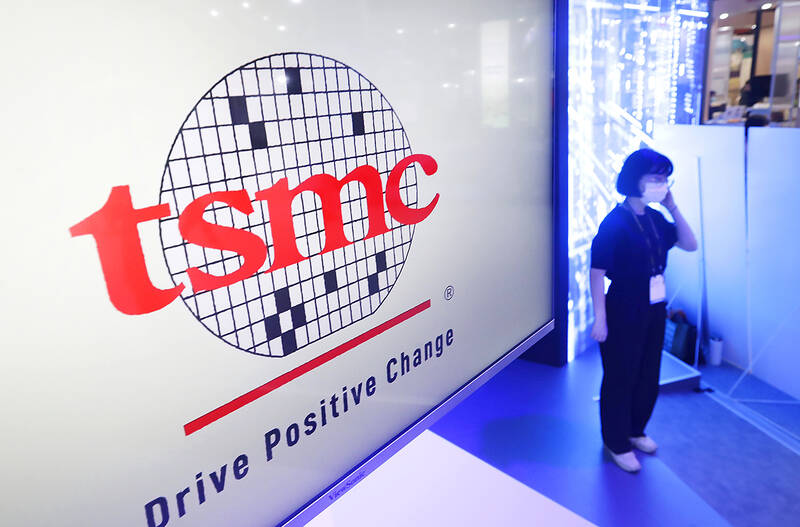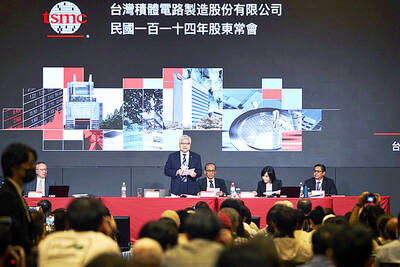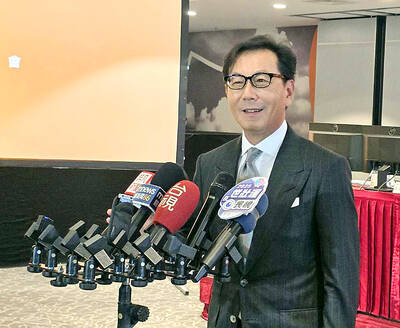Taiwan Semiconductor Manufacturing Co’s (TSMC, 台積電) quarterly sales topped estimates, reinforcing investor hopes that the torrid pace of artificial intelligence (AI) hardware spending would extend into this year.
The go-to chipmaker for Nvidia Corp and Apple Inc reported a 39 percent rise in December-quarter revenue to NT$868.5 billion (US$26.35 billion), based on calculations from monthly disclosures. That compared with an average estimate of NT$854.7 billion.
The strong showing from Taiwan’s largest company bolsters expectations that big tech companies from Alphabet Inc to Microsoft Corp would continue to build and upgrade datacenters at a rapid clip to propel AI development.

Photo: Chiang Ying-ying, AP
Growth accelerated for TSMC last month, capping 34 percent revenue growth for last year. That compares with TSMC’s official target of a 30 percent annual rise, although that outlook was expressed in US dollar terms. The world’s largest maker of advanced chips has been one of the biggest beneficiaries of a global race to develop AI.
TSMC’s market value nearly doubled last year, and it now trades in the US at a valuation close to US$1.1 trillion. However, some investors worry about when the AI boom would peter out. While TSMC’s revenue beat, it was just 1.6 percent higher than the average projection and fell short of the most bullish analyst expectations.
More bearish market observers point to potential over-building, bottlenecks to development such as power shortages, and the persistent absence of a killer AI app or service that would use up all of that server capacity.
The company’s gross margin is likely to expand to a two-year high of 58 percent or more, Bloomberg analyst Charles Shum said.
Four areas merit attention, Shum said.
First, the outlook for chip-on-wafer-on-substrate advanced-packaging capacity build and revenue, which is likely to give insight into the expected strength for AI chip demand in the coming twelve to eighteen months, he said.
Second, progress on the US Arizona fab’s ramp-up, which is critical to meeting the onshoring chipmaking needs of Apple, Nvidia and others, he said.
Third, potential margin pressure from weaker demand in 7-nm, 16-nm and larger mature nodes, he said.
Finally, capital-spending plans this year, which would signal TSMC’s confidence in the uptake of its next-generation N2 node, he added.
The US has also erected a web of restrictions to curtail the flow of Nvidia’s most powerful chips to China, with uncertain longer-term ramifications for TSMC’s key customer.
Morgan Stanley expects TSMC to project annual sales growth of low-20 percent in dollar terms. “TSMC usually guides conservatively at the beginning of the year, and then over-delivers,” analyst Charlie Chan wrote, adding that the company raised its outlook for growth over the course of last year and might again be starting from a more conservative position at the start of a new year.

CAUTIOUS RECOVERY: While the manufacturing sector returned to growth amid the US-China trade truce, firms remain wary as uncertainty clouds the outlook, the CIER said The local manufacturing sector returned to expansion last month, as the official purchasing managers’ index (PMI) rose 2.1 points to 51.0, driven by a temporary easing in US-China trade tensions, the Chung-Hua Institution for Economic Research (CIER, 中華經濟研究院) said yesterday. The PMI gauges the health of the manufacturing industry, with readings above 50 indicating expansion and those below 50 signaling contraction. “Firms are not as pessimistic as they were in April, but they remain far from optimistic,” CIER president Lien Hsien-ming (連賢明) said at a news conference. The full impact of US tariff decisions is unlikely to become clear until later this month

Popular vape brands such as Geek Bar might get more expensive in the US — if you can find them at all. Shipments of vapes from China to the US ground to a near halt last month from a year ago, official data showed, hit by US President Donald Trump’s tariffs and a crackdown on unauthorized e-cigarettes in the world’s biggest market for smoking alternatives. That includes Geek Bar, a brand of flavored vapes that is not authorized to sell in the US, but which had been widely available due to porous import controls. One retailer, who asked not to be named, because

CHIP DUTIES: TSMC said it voiced its concerns to Washington about tariffs, telling the US commerce department that it wants ‘fair treatment’ to protect its competitiveness Taiwan Semiconductor Manufacturing Co (TSMC, 台積電) yesterday reiterated robust business prospects for this year as strong artificial intelligence (AI) chip demand from Nvidia Corp and other customers would absorb the impacts of US tariffs. “The impact of tariffs would be indirect, as the custom tax is the importers’ responsibility, not the exporters,” TSMC chairman and chief executive officer C.C. Wei (魏哲家) said at the chipmaker’s annual shareholders’ meeting in Hsinchu City. TSMC’s business could be affected if people become reluctant to buy electronics due to inflated prices, Wei said. In addition, the chipmaker has voiced its concern to the US Department of Commerce

STILL LOADED: Last year’s richest person, Quanta Computer Inc chairman Barry Lam, dropped to second place despite an 8 percent increase in his wealth to US$12.6 billion Staff writer, with CNA Daniel Tsai (蔡明忠) and Richard Tsai (蔡明興), the brothers who run Fubon Group (富邦集團), topped the Forbes list of Taiwan’s 50 richest people this year, released on Wednesday in New York. The magazine said that a stronger New Taiwan dollar pushed the combined wealth of Taiwan’s 50 richest people up 13 percent, from US$174 billion to US$197 billion, with 36 of the people on the list seeing their wealth increase. That came as Taiwan’s economy grew 4.6 percent last year, its fastest pace in three years, driven by the strong performance of the semiconductor industry, the magazine said. The Tsai